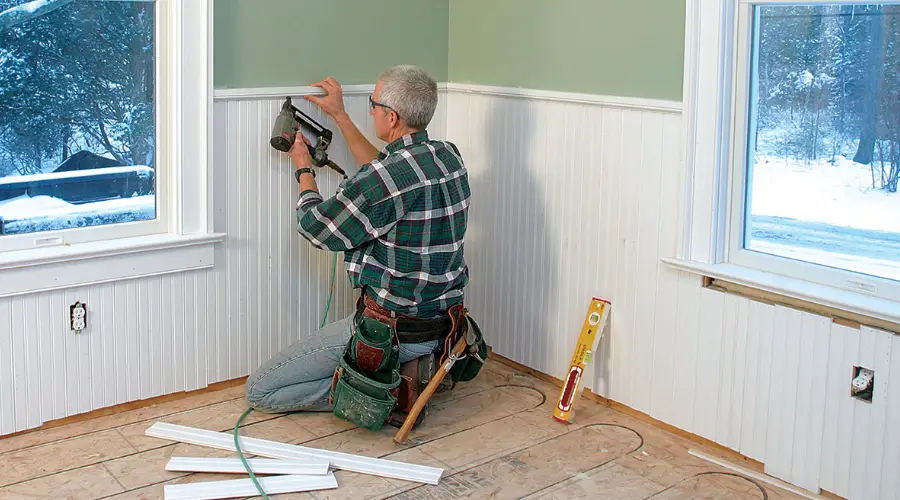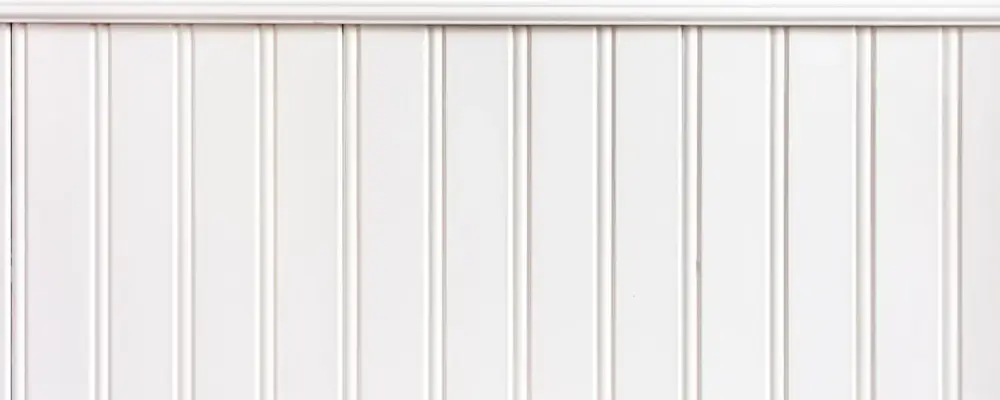Is it possible to inject a tad bit of character and charm into your house without doing all the big renovations? What if one design element suddenly made all the mood alterations on the walls and ceilings, or maybe that furniture piece? Having somewhat quietly worked into the spotlight of modern design is an eternal detail called beadboard.
That is a big comeback from classic texturing to give either warm cottage charm or sleek, contemporary appeal. So, what exactly is beadboard, and why has it become such a popular choice in interior design lately? Allow us to peel some layers away from this designer favourite and see if it might be what your house was waiting for.
What is a Beadboard?
A beadboard is a type of panelling formed of vertical planks separated by evenly spaced grooves or indentations known as “beads.” Historically treated as individual boards, recent beadboards have been largely premade in panels to speed application. Beadboard is typically 32 to 48 inches high when used as wainscoting, covering the lower portion of walls, but it can also be installed full-height to cover entire walls or ceilings, depending on the design style. They can not only enhance beauty and aesthetic appeal but also add a practical protective layer against scuffs and dents.
Key Features of Bead Board
- Textural Depth: These vertical grooves lend depth and texture to otherwise flat walls.
- Versatility: Works well in both traditional and contemporary interiors.
- Durability: Guards against small damages to walls, especially in high-traffic zones.
- Moisture Resistance: PVC-based beadboard is the ideal cladding for kitchens and bathrooms.
- Easy Installation: Pre-cut panels make for a quick DIY installation.
- Customizable: Can take any colour; either paint, stain, or finish to adhere to a particular colour scheme or décor theme.
Application of the Bread Board
Beadboard can find lots of applications in different parts of a house, which include:
- Wainscoting: Installation on half walls for a bit of classic style that also keeps the walls from wear.
- Ceilings: Bring in interest and a vintage charm to flat ceilings.
- Cabinetry: Often used on kitchen cabinets or bathroom vanities to create that cottage or rustic look.
- Mudrooms & Entryways: Provides the kind of durability and easy-to-clean surfaces needed in high-use areas.
- Backsplashes: Used for warm textured looks, especially in farmhouse-style kitchens.
Types of Beadboard Materials
Wood Beadboard
Traditional and highly authentic, wood beadboards present a natural grain and deep texture. Usually, pine or oak is used, and the beadboards can also be stained or painted. Best for dry indoor situations. This beadboard material is known for its natural appearance, high-end finish. On the flip side, it is prone to warping or swelling in humid conditions.
MDF Beadboard
Medium-density fiberboard presents an affordable alternative to solid wood. It’s smooth, easy to paint, and pre-primed. The main advantage of MDF beadboard is its cost, uniform texture, and easy handling. However, it is not suitable for damp areas, since it absorbs moisture.
PVC Beadboard
Manufactured from plastic polymers, PVC beadboards are a great choice for wet environments such as bathrooms, kitchens, and laundry rooms. They are waterproof while being mould-resistant. This beadboard is resistant to moisture and is free from maintenance. On the other hand, this beadboard lacks the warmth of wood, as it offers a purely synthetic look.
How To Install Beadboard?

Prepare the Surface
Make sure the surface of the wall is clean, dry, and smooth. Remove any nails, bumps, and debris from the wall that might obstruct the installation. Once it is ready, take a level and draw a straight horizontal line where the top of the beadboard will go. This will become your reference during installation to make sure the panels stay even.
Cut the Panels
To cut the beadboard panels to the correct height, use a circular saw or jigsaw. It is important to be accurate in your cuts so that the panels look snug and line up correctly when installed.
Apply Adhesive (Optional)
This step is optional, as construction adhesive applied on the back of each beadboard panel will increase the holding strength. This is especially helpful if installing over drywall or just want a more secure fit.
Position and Nail
Starting at one end, carefully set each panel against the wall. Nail the panel in place using finishing nails or a nail gun while making sure grooves between the panels are aligned perfectly for a seamless look. Install all panels while maintaining this alignment.
Install Trim
For further good looks, put in chair rail moulding or decorative moulding above the beadboard. Baseboards can be put in if they are not present already to complete the job neatly and professionally.
Fill and Sand
After all panels and trim are affixed, fill nail holes with wood putty, as well as any filled gaps. Let the putty dry and then sand the surface smooth, ready for painting or staining.
Paint or Finish
In case the beadboard is bare, it would be wise to first prime it (depending on present condition) and then paint or stain it to the shade of your choice. This last process is both for appearance and to seal the wood surface.
How To Paint Beadboard?
- Clean the Surface: Eliminate any loose particles, grime, or oily residue.
- Primer: Particularly on wood or MDF, apply an excellent coat of primer.
- Selection of Paint: Semi-gloss or satin paint would be ideal since they yield a durable finish and are easy to clean.
- Brush and Roller: The brush will allow you to paint inside grooves, whereas the roller will ensure a smooth finish on flat areas.
- Two Coats: Apply two coats of paint for a rich and uniform finish.
- Dry and Inspect: Once dry, inspect and touch up any areas that were missed.
Key Difference Between Wainscoting vs Beadboard
| Feature | Beadboard | Wainscoting |
| Overview | It is a type of panelling with evenly spaced beads (grooves). | It is a type of decorative wall panelling that includes beadboard, raised panels, flat panels, or board-and-batten styles. |
| Appearance | Features narrow planks with uniform grooves between each panel, creating a repeating vertical line pattern. | It does not have a specific appearance, and can vary in styles, making it more customisable in terms of looks and designs. |
| Installation Height | It is most commonly installed on the lower half or third of a wall. However, full-height installations are also possible. | Often ranges from 3 inches to full wall height, but is traditionally installed on the lower third of walls, capped with moulding. |
| Material Options | Available in Wood, MDF, and PVC panels. | Available in wood, MDF, plywood, or even plaster. It offers more flexibility, based on the panel type and finish. |
| Installation | Easy to install with pre-fabricated panels and is DIY-friendly. | Installation of wainscoting is complex, due to the custom sizing, panel layering, and moulding requirements. It requires expert installation. |
| Functionality | Mainly used for decorative texture and minor wall protection in high-traffic areas. | Used for both aesthetic and structural wall protection, mainly for adding architectural interest and increasing property values. |
Conclusion
Beadboard remains a timeless choice, bringing charm, character, and functionality to a wide range of interior spaces. Its ease of installation, versatile applications, and variety of available materials make it a favourite among homeowners and architects alike. Whether it’s used to elevate a bathroom wall, enhance a kitchen backsplash, or add visual interest to an otherwise plain hallway, beadboard consistently delivers that classic, enduring appeal.

